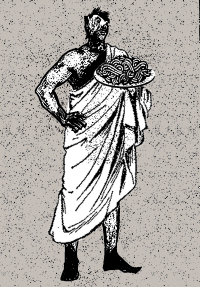 A recurring series in which we take a look back at the city’s most familiar advertising icons.
A recurring series in which we take a look back at the city’s most familiar advertising icons.
What stands twenty-five feet tall, wears a toga with a garland of grape leaves and was a fixture of the city’s “Restaurant Row†for thirty-five years? If you said “The Spaghetti Giant,†then are you ever correct!
Between 1949 and 1984, the Family Italiano restaurant at the corner of Finnegan Curve and Finnegan Row was not only famous for its inexpensive, family-style buffet dinners and heaping plates of its trademark spaghetti and lasagna dishes, but for the titanic plaster mascot which stood proudly in the center of its parking lot.
Literally tens of thousands of area children have squealed in delight from the gates of their parents’ station wagons as they’ve pulled into the parking lot, seeing the beaming face of the Giant looking protectively across the rows of patrons’ automobiles (While dozens of area teenagers may remember the homecoming night tradition of sneaking under the Giant’s toga and painting school slogans across his massive inner thighs).
The Spaghetti Giant became such an inspired and recognized icon that he quickly found his way – in a much-less colossal illustrated form – onto the menu, promotional plastic cups, novelty bibs and more!
The Spaghetti Giant – and the Family Italiano restaurant itself – were both the brainchild of Giuseppe “Jerry Joe†Vivaldi, a first generation American son of Italian immigrants, and the eldest of ten children.
As a young man, Jerry Joe grew frustrated with the lack of authentic Italian restaurants in the city. When he opened the Family Italiano in 1949, there were only three other Italian restaurants, none of which were owned or operated by genuine Italian cooks or families (Two were owned by Swedish and Australian families, respectively, and the third was Swiss engineer Werner van der Hoef’s ill-conceived “Italian Automat,†which closed after only seven weeks of operation and a catastrophic fire which burned for three days).
For Jerry Joe, dinner was an event involving piling helpings of his mother’s good food, and his nine sisters and brothers clamoring for thick slices of lasagna and heaping bowls of linguini. These were the sorts of meals he brought to the Family Italiano, but more than that, Jerry Joe brought his own brand of showmanship.
 Purchasing a twenty-five foot tall plaster Paul Bunyan giant “muffler man” from a local failing auto repair shop, Jerry Joe had it installed on the restaurant property. The canny and cost-conscious Jerry Joe traded hearty, home-cooked meals with local fraternities in exchange for the labor necessary to transform the towering Bunyan into Vivaldi’s vision of a suitable Spaghetti Giant mascot. Three Greek houses and two sororities contributed their efforts, repainting the figure, shaving off Bunyan’s beard, casting a toga out of plaster and replacing the axe with a delicious-looking but ultimately inedible eight-times larger-than-life bowl of plaster spaghetti.
Purchasing a twenty-five foot tall plaster Paul Bunyan giant “muffler man” from a local failing auto repair shop, Jerry Joe had it installed on the restaurant property. The canny and cost-conscious Jerry Joe traded hearty, home-cooked meals with local fraternities in exchange for the labor necessary to transform the towering Bunyan into Vivaldi’s vision of a suitable Spaghetti Giant mascot. Three Greek houses and two sororities contributed their efforts, repainting the figure, shaving off Bunyan’s beard, casting a toga out of plaster and replacing the axe with a delicious-looking but ultimately inedible eight-times larger-than-life bowl of plaster spaghetti.
(Here’s a Fun Fact: Leftover house paint from Jerry Joe’s own bungalow was used to paint the Spaghetti Giant’s patented bowl of spaghetti. Between the years of 1953 and 1961, local house paint distributors were more popularly asked for tins of “Spaghetti Giant Yellow†than any other custom color request!)
While the Family Italiano restaurant itself is long-gone, the Spaghetti Giant itself continues to live on, in a fashion.
Increasing gentrification of the area forced Jerry Joe to close his doors, as his budget-conscious pricing couldn’t keep apace of ever-increasing property taxes. In 1994, the vacant restaurant – still under the watchful eye of the Spaghetti Giant – was sold to a local restauranteur and transformed into Le Café Bruleé.
Unfortunately for the new owners, stricter zoning laws prohibited the erection of new signage alongside any corner-oriented establishment – including the newly founded, upper-class French eatery. If the Spaghetti Giant were torn down, according to local law, no sign could go up to replace him.
This is why you might have noticed a widely grinning, twenty-five foot tall sous-chef currently populating the corner of Finnegan Curve and Finnegan Row. It seems that the Spaghetti Giant himself may be gone, but – in whatever form he may take – he remains a vibrant thread in the fabric of this city’s most meaningful advertising icons.
– J. Morris

2 comments for “What a Character!: The Spaghetti Giant”